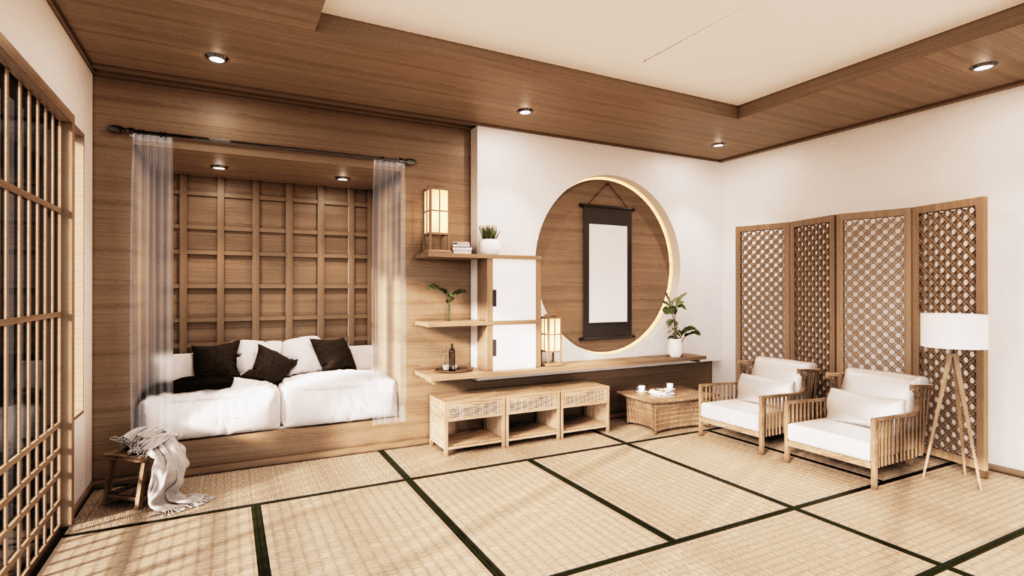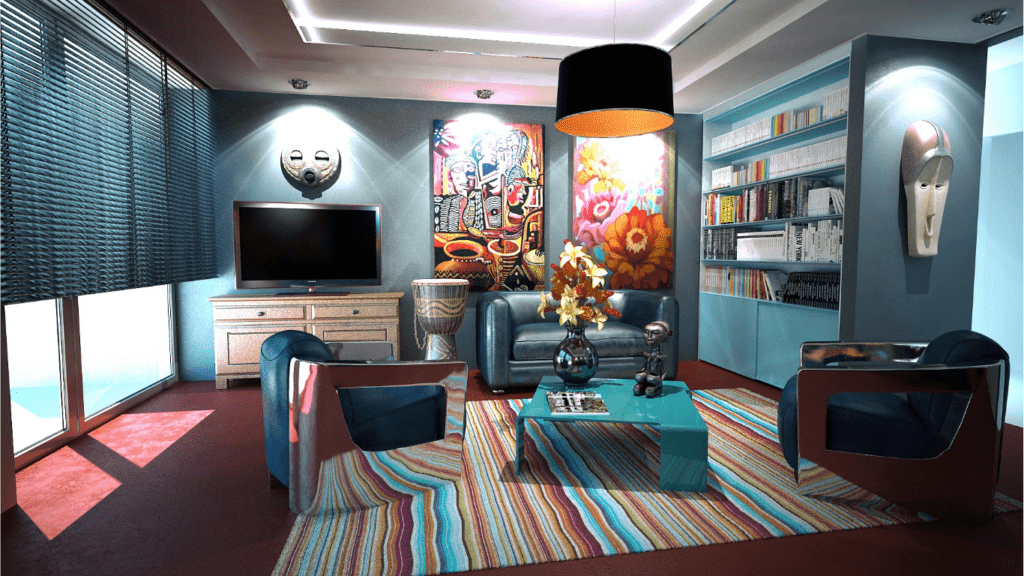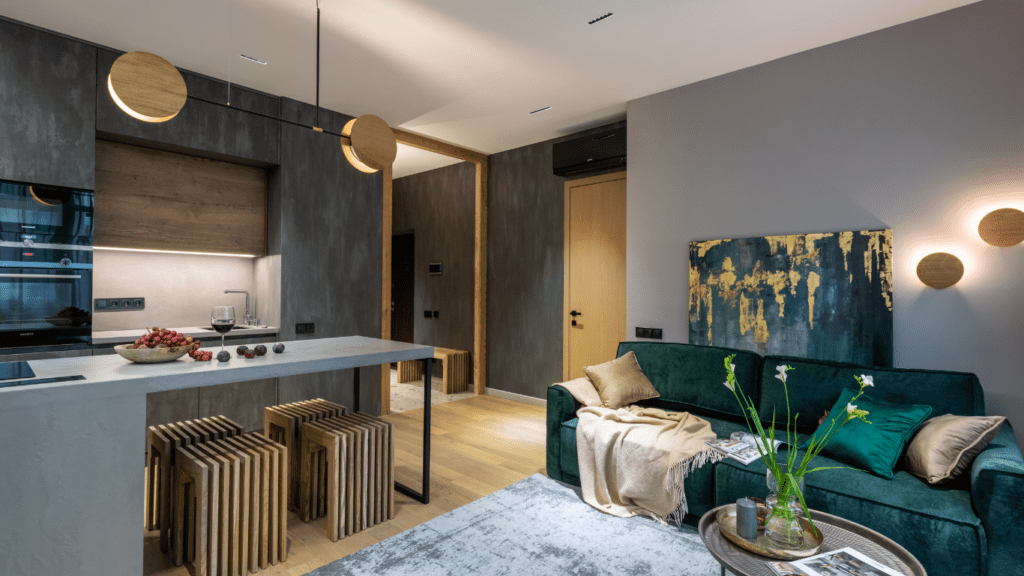Understanding Japandi Style
Japandi style combines Japanese and Scandinavian design elements to create an environment that is both minimalist and warm. Drawing from each tradition, Japandi fosters simplicity without sacrificing comfort. By merging the clean lines and neutral colors typical of Scandinavian interiors with the natural materials and functional elegance of Japanese design, spaces become both visually appealing and practical.
Key Characteristics
Japandi design focuses on shared principles between the two styles. It stresses simplicity, functionality, and a deep connection to nature.
- Simplicity: Japandi interiors embrace minimalism. Spaces are free of clutter, enhancing a sense of calm and tranquility. Clean lines and unobtrusive details underscore this principle. For example, a living room might feature simple wooden furniture and minimal decor items.
- Functionality: Every piece in a Japandi room serves a purpose. There’s an emphasis on multi-functional furniture and thoughtful, efficient use of space. A dining table with built-in storage is a common example.
- Natural Elements: Both Japanese and Scandinavian designs value nature. Japandi integrates natural materials like wood, stone, and bamboo. Houseplants are frequently used to bring the outside in, promoting a serene, organic feel.
Color Palette
Japandi color schemes typically include neutral tones. Think whites, beiges, and soft grays as base colors, complemented by darker elements to add contrast and depth.
- Neutral Tones: Base colors are often light, including shades like off-white and light gray. These tones create a clean, airy feeling.
- Darker Accents: Charcoal, black, and deep blue accents add contrast. These darker elements help to ground the space and provide visual interest. An example could be a light beige sofa paired with dark throw pillows.
Furniture and Decor
Furniture in Japandi style is simple and low-profile. Pieces are chosen for their functionality and form.
- Low-profile Furniture: Japandi favors furniture that is low to the ground and has simple, clean lines. Examples include platform beds and low coffee tables.
- Natural Materials: Wood is predominant, often featuring light finishes that showcase the material’s natural beauty. A wooden dining table with a raw edge finish is one example of this characteristic.
- Minimal Decor: Decorative items are used sparingly. Each piece has a purpose and adds to the overall aesthetic. An example includes a single, well-placed vase with a few branches or flowers.
Enhancing the Atmosphere
To enhance the serene atmosphere, Japandi uses natural light and organic textures to create harmony and balance.
- Natural Light: Large windows and sheer curtains are used to maximize natural light, fostering an open and airy environment. Intentional lighting designs ensure rooms are well-lit without being harsh.
- Organic Textures: Adding texture through textiles and organic materials enhances warmth. Linen cushions, woolen throws, and woven rugs are examples that bring a tactile element to the space.
By understanding and applying these principles, the Japandi style helps create spaces that are both beautifully minimalist and invitingly warm.
Core Principles of Japandi Design

Japandi design hinges on a fusion of Japanese elegance and Scandinavian simplicity. It creates spaces that are minimal yet warm and inviting.
Emphasis on Minimalism
Minimalism lies at the heart of Japandi design. The aim is to remove clutter and retain only what’s essential. In Japandi interiors, every item serves a purpose and often features multi-functional designs. For example, a low-profile table may double as storage. This approach not only saves space but also promotes a sense of calmness. The focus remains on simplicity and clean lines, enhancing the overall aesthetic.
Focus on Natural Elements
Natural elements play a crucial role in Japandi design. Materials like wood, stone, and bamboo are prominently featured. For instance, wooden floors and furnishings add warmth while stone countertops provide durability and a touch of organic beauty. Adding houseplants enhances the natural feel, bringing life into the space. These elements help create an environment that’s both functional and organically beautiful.
Harmonious Color Palette
The color palette in Japandi design strikes a balance between neutrality and contrast. Typical colors include whites, beiges, and soft grays, complemented by darker shades like charcoal and deep blue. These colors create a serene atmosphere. Low-profile furniture usually features natural finishes, blending seamlessly with the color scheme. Each color and finish is carefully chosen to contribute to a harmonious and balanced look.
By focusing on these core principles, Japandi design offers a unique blend of minimalism and warmth, ensuring spaces are both functional and inviting.
Key Elements of Japanese Design
Japanese design principles focus on achieving balance and harmony through minimalism and nature-inspired elements.
Wabi-Sabi Philosophy
Wabi-Sabi involves celebrating imperfection, impermanence, and simplicity. In Japandi style, I often see this reflected in natural textures, uneven surfaces, and handcrafted items. For example, a wooden table with visible grain patterns or a ceramic vase with slight variations in glaze exemplifies Wabi-Sabi. Using these elements adds authenticity and timeless beauty to the space.
Shibui Aesthetic
Shibui represents simple, subtle, and unobtrusive beauty. When integrating Shibui into Japandi design, I choose furniture and decor that are understated yet elegant. This includes items like low-profile wooden chairs, neutral-toned linens, and wall art with minimalist designs. Each choice creates a calm and balanced environment, enhancing the overall aesthetic without overwhelming the senses.
Fundamental Aspects of Scandinavian Design
Scandinavian design focuses on simplicity, functionality, and comfort. It draws inspiration from nature, creating spaces that are both practical and inviting.
Hygge Concept
The Hygge concept is central to Scandinavian design. It prioritizes coziness and well-being by creating a warm atmosphere. Soft textiles, candlelight, and comfortable seating enhance a sense of tranquility. For example, integrating fluffy throws and plush cushions transforms a living space into a serene retreat.
Functional Furniture
Functional furniture is a hallmark of Scandinavian design. Pieces serve dual purposes and incorporate storage solutions. For instance, a coffee table might include hidden compartments. Clean lines and minimal ornamentation ensure that furniture is as practical as it is aesthetically pleasing. By selecting multi-functional items, clutter is minimized, maintaining an uncluttered and peaceful environment.
How to Incorporate Japandi Style in Your Home
Japandi style seamlessly blends the minimalist elegance of Japanese and Scandinavian design. To transform your living space, focus on these key elements.
Choosing the Right Furniture
Prioritize pieces that combine functionality with aesthetic appeal. Select furniture that serves multiple purposes, such as a low-profile table with storage compartments. Opt for natural materials like wood and bamboo. Stick to neutral colors like beige, white, and gray. Incorporate darker accents like charcoal to add contrast.
Selecting Textiles and Accessories
Textiles and accessories add warmth and texture to a Japandi space. Choose soft, natural fabrics like cotton or linen for pillows, throws, and curtains. Limit decor items to a few carefully chosen pieces. Opt for handcrafted items to bring authenticity and a touch of imperfection. Incorporate houseplants for a natural touch.
Balancing Light and Space
Light and space are crucial in Japandi design. Maximize natural light with large windows and keep window treatments minimal. Use soft, ambient lighting to create a tranquil atmosphere. Arrange furniture to maintain an open, uncluttered space. Employ mirrors to reflect light and enhance the sense of space.



 Betsylie Sheetsin – Home Renovation Expert
Betsylie Sheetsin serves as the Home Renovation Expert at Castle Shelf House, specializing in giving practical advice for both small and large-scale home improvements. With years of experience in construction and renovation, Betsylie understands the importance of blending durability with design. Her insights into home renovation projects, along with expert advice on the latest materials and techniques, empower homeowners to tackle even the most ambitious projects confidently.
Betsylie Sheetsin – Home Renovation Expert
Betsylie Sheetsin serves as the Home Renovation Expert at Castle Shelf House, specializing in giving practical advice for both small and large-scale home improvements. With years of experience in construction and renovation, Betsylie understands the importance of blending durability with design. Her insights into home renovation projects, along with expert advice on the latest materials and techniques, empower homeowners to tackle even the most ambitious projects confidently.
